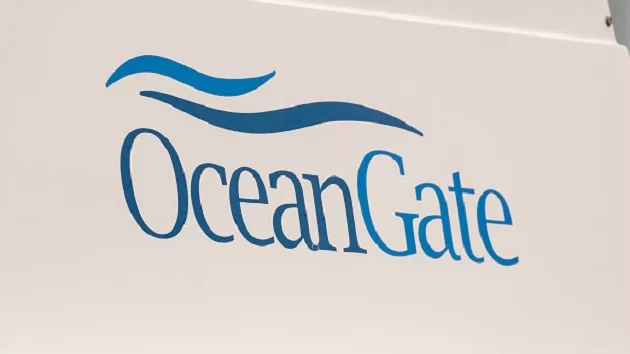
(NEW YORK) — The company behind the lost Titanic tourist submersible exaggerated the details of the industry partnerships behind the development and engineering of its Titan submersible.
The submersible likely suffered a “catastrophic implosion” based on debris located 1600 feet from the wreckage of the Titanic, according to the Coast Guard. The five passengers aboard the experimental deep-sea vessel “have sadly been lost,” according to the submersible company OceanGate Inc.
The deadly implosion of the Titan submersible, a vessel which OceanGate once said would mark the “beginning of a new era of exploration,” leaves open questions about how the upstart company was able to not only operate the vessel but also convince paying customers to travel aboard it.
In some public statements, the company suggested that its Titan submersible — the company’s only vessel able to reach Titanic depths — was designed and engineered with the assistance of entities such as Boeing, the University of Washington and the National Aeronautics and Space Administration. In statements to ABC News, each entity described its role in Titan submersible, or lack thereof, as more limited than sometimes stated by OceanGate.
When asked about these exaggerations about the role of partnerships in the development of the Titan submersible, an OceanGate representative declined to comment on the matter.
“The state-of-the-art vessel, designed and engineered by OceanGate Inc. in collaboration [with] experts from NASA, Boeing and the University of Washington, made its subsea debut in 2018,” OceanGate Expeditions — the Bahamas-based company that operates U.S.-based OceanGate Inc. submersibles — said about the Titan submersible on its now inaccessible website.
OceanGate’s founder and CEO Stockton Rush — who was aboard the missing vessel — made similar statements about his company’s partnerships during an interview with CBS News correspondent David Pogue in 2022, who asked about the construction of the Titan submersible, which Rush said used some minor parts purchased from consumer retailers like Camping World.
“The pressure vessel is not MacGyvered at all because that’s where we worked with Boeing and NASA, [and] University of Washington,” Rush said. “Everything else can fail. Your thrusters can go, your lights can go. You’re still going to be safe.”
Kevin Williams, the executive director of the University of Washington’s Applied Physics Laboratory, told ABC News the school and laboratory were also not involved in the “design, engineering or testing” of the Titan submersible.
Victor Balta, a UW spokesperson, added that OceanGate and UW’s Applied Physics Laboratory initially signed a $5 million collaborative research agreement, but the two entities “parted ways” after only $650,000 of work was completed. That research only resulted in the development of another OceanGate submersible, the shallow-diving Cyclops I submersible, according to Balta.
The steel-hulled Cyclops I is only rated to reach 500 meters, compared to the Titan, which is constructed from carbon fiber and titanium to reach depths of 4,000 meters, the company said.
“The University’s and Laboratory’s engineering partnership with OceanGate ended with the completion of the shallow water vessel CYCLOPS, which served as a test platform for OceanGate since 2015,” Williams said. “Because APL-UW expertise involved only shallow water implementation, the Laboratory was not involved in the design, engineering or testing of the TITAN submersible used in the RMS TITANIC expedition.”
Balta added that OceanGate contracted with the school to use testing tanks on a contractual basis for nine tests between 2016 and 2022.
“No UW researchers were involved in any of those tests and UW personnel did not provide any verification or validation of any OceanGate equipment as a result of those tests,” Balta said in a statement.
When asked about the details of those relationships with OceanGate, a Boeing representative told ABC News that the aerospace company was not involved in designing or building the deep-sea submersible.
“Boeing was not a partner on the Titan and did not design or build it,” a Boeing spokesperson told ABC News in a statement.
In a 2021 press release, OceanGate thanked “industry partner” Boeing for their “design and engineering support” related to the Titan submersible.
OceanGate also made repeated statements in press releases about its involvement with NASA, including thanking the entity for design and engineering support.
“NASA’s Marshall Space Flight Center in Huntsville, Alabama, will serve as the facility where the development and manufacturing of a new aerospace-grade hull is completed,” the company wrote in a 2020 press release. It also said NASA would be involved in the testing of the “new carbon fiber pressure vessels.”
A 2022 press release walked back the description of NASA’s involvement, saying a team of NASA engineers only consulted throughout the development and engineering of the project.
In a statement to ABC News, NASA confirmed it consulted on materials and manufacturing for the Titan submersible pursuant to an agreement with OceanGate.
“NASA did not conduct testing and manufacturing via its workforce or facilities, which was done elsewhere by OceanGate,” the statement said.
The strength of OceanGate’s purported industry partnerships was used to build credibility with industry groups such as the Marine Technology Society as well as the public who would buy tickets to OceanGate’s expeditions.
“[OceanGate] has invested six years of design and testing of this pressure vessel design in partnership with technology organizations such as the Applied Physics Lab at the University of Washington and the Boeing Company,” the Marine Technology Society noted in its 2017-18 global industry overview of manned underwater vehicles. “OceanGate reports this has given the company full confidence in their novel approach…”
Members of a MTS committee specializing in submersibles later voiced concern that OceanGate was avoiding industry-wide safety standards, according to a 2018 letter. The letter itself, which was never approved to be sent to OceanGate, was leaked to Rush, according to the committee’s chair William Kohnen.
“Your representation is, at minimum, misleading to the public and breaches an industry-wide professional code of conduct we all endeavor to uphold,” the letter said about OceanGate’s marketing materials about the safety of Titan’s design.
“The company had indicated that their state of innovation was beyond, beyond what was allowable within the regulatory standards we have today and that they would proceed without certification,” Kohnen told ABC News, adding that the company heeded some of the comments made in the 2018 letter.
ABC News’ Sam Sweeney, Amanda Maile, Victor Ordonez, and Gina Sunseri contributed to this report.
Copyright © 2023, ABC Audio. All rights reserved.





